Driving in Australia
Fuel Miser Comparison (2010/2022) Smart-VW

I thought I’d look at a list of cars that featured in an article written back in 2010, where I compared some of the thriftiest cars at that time. These were cars which had been designed to function as some of the world’s best fuel sippers. These vehicles were sold new in Australia, but I thought I’d add a new twist this time by adding what we can consider as the brand new version of these old models with their statistics for fuel consumption as a comparison – you know, a bit of nostalgia along with the new, and what’s changed – or not.
Note that the fuel consumption figures are based on the number of litres of fuel consumed every 100 km travelled. Often real world situations can play havoc with Lab tested fuel consumption figures, but this definitely gives you an interesting picture And, here is the list that is in alphabetical order – just to be helpful:
Smart
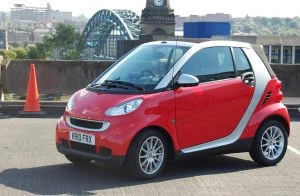
2010 Smart ForTwo
By far the smallest car being talked about in 2010 with excellent fuel consumption was the Smart ForTwo. It still fits into car parks like you wouldn’t believe! Small and safe, comfortable and peppy, any smart CBD commuter would be tempted by the tiny Smart ForTwo. It boasts a combined fuel economy figure that sits well under 5 litres/100 km – and this all coming from a ULP motor. Currently you can’t buy any new Smart car in Australia, though I’ve heard that, in the near future, they are making a comeback with purely electric power and with new design.
SsangYong
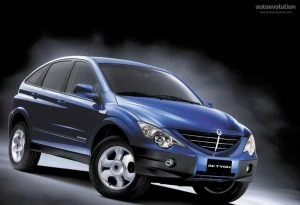
2010 SsangYong Actyon SUV
At the time, the 2010 SsangYong Actyon was about the most frugal SUV you could buy new at an impressively low price. The economic SUV has muscly looks and a rugged design that could see the vehicle handling tough off-road terrain with ease. SsangYong uses a 2.0 litre turbo-diesel engine in this vehicle, which packs over 300 Nm of torque to go with its excellent 4×4 underpinnings. Getting any 1.8 tonne vehicle to manage under 5 litres/100 km is a feat. So, well done to SsangYong! Currently, no more SsangYong vehicles quite match the excellent economy of an Actyon Diesel.
Suzuki
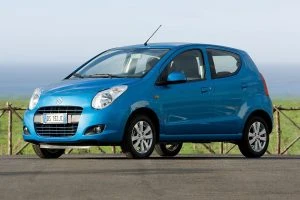
2010 Suzuki Alto
Budget priced, and one of the few petrol powered cars back in 2010 delivering awesome fuel economy was the Suzuki Alto. The Suzuki Alto 1.0 litre GL and GLX has an attainable fuel economy figure of 4.8 litres/100 km. The Suzuki Alto is also nice looking (bug-eyed), has six airbags, and even comes with ESP as standard in the GLX model. Great for around town – you’d be nuts to not consider an Alto.
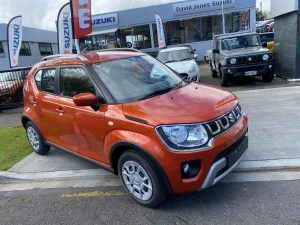
2022 Suzuki Ignis
There are no new Altos in 2022, but Suzuki do offer us the awesome little Suzuki Ignis GL Manual and GLX auto. These cars use a 1.2-litre ULP motor and deliver a similar fuel consumption to the 2010 Alto. Safety in new Suzuki cars has taken a big leap forward, so too has all the modern technology. Brand new Swift and Baleno models are definitely worth a look. These are also economy-driven cars with decent comfort, technology, and practicality.
Toyota
Where would the world be without Toyota? For a very frugal, spacious, and practical drive, the clean burning 2010 Toyota Prius III offered a 1.8 litre petrol hybrid engine. It didn’t come cheap, but it was certainly friendly on the environment. You could expect around 4.0 litres/ 100 km – sometimes better.
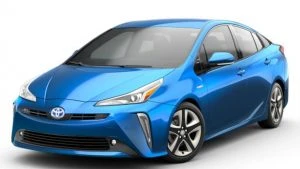
2022 Toyota Prius
You can now buy a 2022 Toyota Prius model for between $42–50k. These are nice cars and much more impressive to look at than the older models. They are safe and packed with excellent features. The Prius still continues with the same petrol-electric engineering that made it such a standout when it was launched in 2001. The same basic technology remains for the 4th-generation Prius, as well as all Toyota/Lexus hybrids these days. So, what a new Prius offers is a small-capacity 4-cylinder engine that works through a planetary gear set to dispense the delivery of power to the front wheels (or also the rear wheels in SUV variants). The current Toyota Prius is powered by a 72kW/142Nm 1.8-litre engine that combines with an electric motor to produce a joint maximum power output of 90kW and a claimed fuel consumption of 3.4 litres/100km. Better than ever! Toyota newest vehicles: the CH-R, Camry, Corolla, RAV-4, and Yaris Hybrid models are available with very low fuel consumption figures. Toyota and Honda are masters of the Hybrid-game, and have been for quite some time.
VW
Back in 2010, the Germans offered plenty of cars with excellent fuel consumption. Volkswagen has for a long time offered well-designed, reliable and fuel efficient motorcars. They are generally refined, elegant, and roomy, and the 2010 VW Golf 77TDI variant easily boasts fuel economy figures below 5 litres/100 km on a combined cycle.
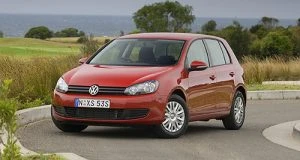
2010 VW 77TDI
2022 sees the Golf Hatch with 5 models, and in Wagon form it has a couple of nice new variants. The base models use a 110TSI 1.4-litre ULP motor, which is a 4-cylinder that is smooth and can return a claimed 5.8 litres/100 km. 250 Nm of torque offers muscle when you need it, and the car cruises at high speed effortlessly. The 8th-generation of the Golf brings not only fresh external and interior design, but it is also the safest, most tech-laden ever.
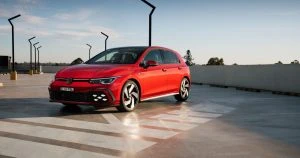
2022 VW Golf 110TSI
There are other new cars right across the auto-manufacturing spectrum now that offer superb fuel economy or EV power alone. It’s interesting how in that time (2010–2022) we’ve seen auto manufacturers taking a shift away from providing the new-car buyer with several frugal diesel family options to a fleet that is now a lot more Hybrid in flavour. It’s a change coerced by new government law and regulation. However, hybrid vehicles are superb automobiles that offer top fuel consumption figures and practicality, creating that much needed bridge between purely fossil fuel vehicles and completely EV-powered automobiles
Do check out the brand new arrivals. Cars like the Hyundai IONIC, Hyundai KONA, Kia EV6, Kia Niro, Mazda MX-30, BMW i and Hybrid models, Mercedes Benz EQA and EQC models, MG HS EV, Polestar cars, Tesla, and Volvo’s Recharge and Hybrid models are just some of the amazing new cars available that we can now buy that weren’t even a showing back in 2010.
Happy commuting!
Let’s Go and Caravan

We’ve got the country, we’ve got the beauty, and it seems peoples’ love for caravanning and camping around Oz is growing steadily. The latest figures from Tourism Research Australia show that the popularity of domestic caravanning and camping trips is one pastime that many Australians cherish. It’s not hard to see why people enjoy it, when there is so much natural beauty in Australia’s landscapes and wildlife.
According to the latest domestic tourism record, it shows that Australians spent a total of 54.5 million nights caravanning and camping during the year ending March 2019. This number is an increase of 6.5% from the previous year. While on these trips, many caravanners and campers also opted to eat out at local cafes or restaurants, a bonus for the local businesses. This growth was experienced across the board, in all States and Territories, with over 10% growth recorded for Northern Territory, South Australia, Victoria, Tasmania and Queensland. Interestingly, in terms of age demographics, those with a family in tow – i.e. parents with one or more children living at home – belonged to the demographic group that accounted for the largest number of caravan/camp trips in a year. People who were part of the younger, mid-life demographic, and with no children, were those of the second largest group taking plenty of caravanning or camping trips (4.2 million). When it comes to the most nights away in a year, the older non-working demographic (often called ‘grey nomads’) were leading the way with 32% of the total number of nights spent in Australia caravanning or camping. In comparison, the family segment was only slightly less at 30%.
Sorry tenters, but I’m getting older and so will give my few cents worth for caravanning in the following! I enjoy getting away in our caravan when we can. Having a caravan in tow allows for a little more comfort on the trip, with less hassle on arrival at each new destination. Everything you really need is with you, and the beds are ready made for the night, with no need to pitch tent!
I would certainly recommend trying caravanning, particularly if you like the idea of enjoying the great outdoors, getting away from most of the electronic vices, and smelling the clean air. You get to meet a whole bunch of friendly, like-minded people along the way. You also get to discover the many new places you’ve never seen before or rediscover your old favourite spots that you love to get back to. These sorts of experiences are a treat that I never grow tired of.
Caravan Types
Here are some of the varieties of caravans you can buy without looking into purchasing a fully-fledged motorhome:

Standard Caravan
Easy to tow. It really just depends on the tow rating of your car as to how large or heavy the standard caravan is. The smaller the caravan, generally, the lighter and easier it is to tow than bigger ones. Standard caravans come in a range of sizes, single and tandem axles, and so some of the standard caravans can even be pulled by smaller cars.
Because standard caravans aren’t as heavy as the more ruggedly designed off-road caravans, they demand less torque and horsepower to tow comfortably out on the open road; thus, they are more economical on the fuel/power bill.
Standard caravans are also a bit easier to store and manipulate by hand, particularly the smaller ones.
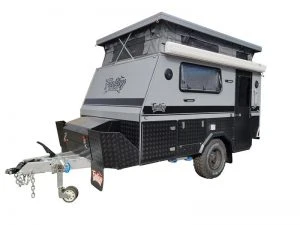
Pop Tops
Pop-tops are easy to tow. Small caravans like pop-ups are, generally, much lighter and easier to tow from A to B than larger types of caravans. You get much better fuel economy towing a pop-top because of the lower drag co-efficiency.
Pop-tops a doddle to store and manipulate by hand, particularly the smaller ones.
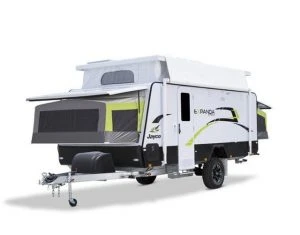
Expander
The merits of an expander caravan are similar to any standard or off-road caravan; however, they have the added bonus of a variety of pop-out areas that can be designed into the ceiling and walls. Essentially, pop these areas out at your destination, and you have a lot more interior space and utility at your disposal while being stationary. Just before you tow away, these areas are fold back into place, and away you tow again.

Off Road Caravan or Camper
The merits of having an off-road capable caravan or camper speak for themselves. They have been built tough and rugged so that you can tow them off-road. Obviously, you are going to need a bigger, torquier vehicle to tow this type of caravan/camper as they are heavier built and weigh more. Usually, these are towed by a decent 4×4 capable vehicle like a Land Rover, Toyota Land Cruiser, Ford Ranger, etc.

Camper Trailer
Similar to a pop-up caravan, except they fold out an array of attached tents. These are light and easy to tow. They can be designed for towing both on and off the road. They are cheaper to buy, as are pop tops.
Hybrids, EVs, and the City Environment

With the big push for clean air and protecting the environment, running a new hybrid vehicle is one way to make the gradual change from fossil fuels to electric more affordable and realistic as we head into a future of EVs.
A gradual change is key, so that everyone can adjust their budgets and business direction accordingly. And making the change gradual ensures that EVs can become more affordable to the masses. Have you heard of the ‘trickle-down effect’? This term refers to the reality of fashion trends flowing from the wealthy (e.g., politicians, mayors, doctors, directors, engineers etc.) to the less well-off or the working class (e.g., factory hands, beneficiaries, shop assistants, cleaners, farm workers, etc.) in society. This trickle-down phenomenon can be related to any new consumer product, especially when these products are first introduced into the market.
At the product’s initial introduction into the marketplace, it is costly and only affordable to the wealthy, but, as the product matures, and as time goes on, its price begins to fall so that it might become more widely affordable and thus adopted by the general public and the working class. One would assume that pure EVs will follow this kind of trend.
Right now, EVs are expensive to purchase new, especially when you want to have one of the EVs with all the status (e.g., Tesla, Porsche, Mercedes Benz). There are some cheaper options like the MG ZS EV, Hyundai IONIQ electric, the Nissan Leaf, and the Hyundai Kona electric. These cars can generally be had for less than $60k.
Currently, owning and operating a 100% EV would be an ideal option if you just wanted to hop between addresses inside the city boundary or maybe commute short distances to and from the urban jungle. However, throw in some intercity travel or long country drives, and the EV is simply left wanting. I’m aware that EV manufacturers are working hard to change this, to make their EVs capable of travelling much longer distances between recharges, as well as making the recharge time much quicker than it commonly is. As it stands today, Australia’s recharging infrastructure is in its infancy, and beyond the city boundary, even inside, it still has a long way to go before becoming seamless and brief.
If you live in and mostly travel inside one of our lovely Australian cities, owning or operating a vehicle that is capable of running on electric power for all or at least some of the time (more depending on you commute or travel patterns) would surely be an option if you aren’t doing so already. This would instantly help to improve the air quality of the congested city environment.
Who wouldn’t want to enjoy breathing cleaner air inside a city’s boundaries? We all would, right? But I can’t afford an EV because (a) it’s not practical and (b) you can’t afford one? If you relate to either of these truths, then you aren’t alone and are currently in the majority. So, what about a Hybrid then? Right now, hybrid vehicles do make a lot of sense. They are able to use their small electric motor for 20–30 km of inner city travel, thus making the city air cleaner and the environment better for all city dwellers and workers. However, when the commute includes distances beyond the city boundary, the petrol motor will happily take over transport duties and to get you where you want to go, recharging the electric motor’s battery in the process.
Of course, a bicycle or even walking is another option for inner city travel, particularly when it isn’t raining. If you are wanting a Hybrid vehicle or even an EV, then do have a look at some of our Hybrid and EV reviews or talk to some of our sales staff to see if there is a likable and affordable option out there for you.
How will Australia manage the EV transition as the UK and Japan make their move?
Japan recently joined the growing ranks of countries that are set to move towards a ban on petrol and diesel-powered new cars, emphasising the need to shift towards a new generation of fuel technology.
With the framework for a transition by the middle of the next decade looking set to be a priority for the Japanese government, it is clear that Japan is ramping up its efforts to achieve a goal of being net carbon neutral by 2050. This means the sale of new cars with internal combustion engines could be at an end by the mid-2030s.
As mentioned above, Japan is merely one of a number of countries making the switch.
European lawmakers have been on the frontline in terms of making changes. And those changes are only coming up quicker, as countries accelerate efforts to meet net zero goals. In the UK, the sales ban on new petrol and diesel-powered cars is now targeting 2030 as opposed to the original timeline of 2035.

How might this impact new cars in Australia?
By now, and after a federal election where a green mandate has been given, you’re probably either chastising our politicians for not following suit, or alternatively, you might be wondering what does this all have to do with Australia?
The ramifications for motorists down under are more complex than you might believe. The UK and Japan are the largest markets in the world for right-hand-drive vehicles. Even Singapore, another right-hand-drive market, has pencilled in a 2040 deadline for the transition away from the internal combustion engine.
While the local government has yet to make any significant inroads as far as incentivising drivers to take up cars powered by electric or hybrid means – in fact, some state governments have introduced road user charges that are hardly helping the cause – this absence is quite stark when compared to overseas markets where motorists have a number of incentives and the infrastructure in place to consider buying a vehicle powered by ‘green’ energy. And of course, EV prices are far more affordable overseas. Uptake is picking up quickly in a number of international markets, with the building blocks in place to encourage drivers to make the switch, and pioneers like Tesla changing the game.
With Australia no longer in the picture as a car manufacturer, nor is it ever likely to be one in the future given the prohibitive costs associated with the industry down under, the prospect of the world leaving Australia behind shouldn’t be ignored.
Not only could Australia be left behind as other countries transition to more efficient and technologically sophisticated vehicles, but the cost of supplying Australia with right-hand-drive vehicles could increase as economies of scale begin to dissipate if not evaporate for car manufacturers. If this happens, you better believe that those companies will be passing on the costs to local motorists in the form of higher prices – as if manufacturers haven’t been increasing prices a number of times over the last couple years already.